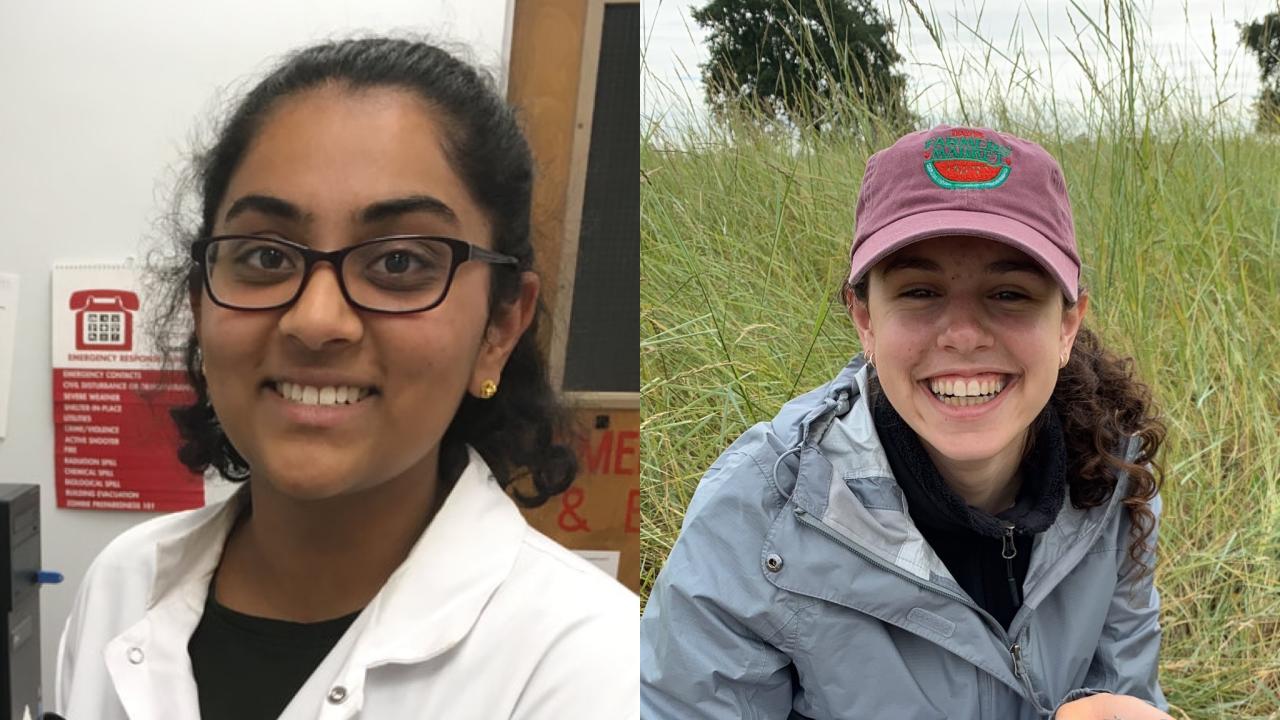
Two UC Davis College of Biological Sciences Students Named Goldwater Scholars
Quick Summary
- Undergraduates Jayashri Viswanathan and Naomi Murray join the 2020-2021 class of Goldwater Scholars, a prestigious undergraduate award program that encourages students to pursue research careers in the natural sciences, engineering and mathematics
- Viswanathan works in the Olson Lab, where she studies how psychedelics can help treat those diagnosed with mental health disorders like depression
- Murray works in the Karban Lab, where she studies the chemical world of plant communication, specifically focusing on interactions between plants and herbivores
Congratulations are in order for College of Biological Sciences students Jayashri Viswanathan, a junior majoring in biochemistry and molecular biology, and Naomi Murray, a junior majoring in evolution, ecology and biodiversity. Both join the 2020-2021 class of Goldwater Scholars, a prestigious undergraduate award program that encourages students to pursue research careers in the natural sciences, engineering and mathematics. Of the 1,343 applicants, only 396 college students received the Goldwater Scholar designation.
“I’m incredibly honored,” said Viswanathan, who noted that the scholarship is encouragement to pursue a career in academia. “The undergrads that they give these awards to go on to do some pretty impactful science.”
“It honestly feels kind of fake,” said Murray, who found out she’d won from a friend. “I definitely didn’t think I was going to get it when I applied.”
The scholarship provides up to $7,500 a year to help cover costs associated with tuition, mandatory fees, textbooks and room and board.
Learn more about the exciting, current research of our UC Davis Goldwater Scholars below.
Mining the mystery of consciousness via psychedelics with Jayashri Viswanathan
When Jayashri Viswanathan first asked Assistant Professor David Olson, Department of Chemistry, about undergraduate research lab opportunities, she didn’t realize “psychoplastogens,” the small molecules Olson studies, were actually psychedelic drugs like LSD and psilocybin. A biochemistry and molecular biology major, Viswanathan simply wanted a research experience that combined her interests in biology and chemistry.
Nearly three years later, she’s performed various experiments on psychedelic compounds, using them to help her lab colleagues explore the neuropathology of psychiatric diseases like depression, anxiety and addiction.
“A lot of the antidepressants currently on the market, they take weeks to take effect and even if they do take effect, a lot of people spend a lot of time trying to find the right mix of medications,” said Viswanathan.

Research shows that up to 30 percent of those with depression show no response or only a partial response to antidepressants. Psychedelics offer a potential therapeutic alternative for those who fall through the cracks. In the lab, psychedelics have been shown to stimulate beneficial neural growth in brain regions affected by mental health disorders like depression.
Researchers in the Olson Lab are designing synthetic analogues of psychedelic drugs that possess therapeutic properties and reduced hallucinogenic potential. Recently, Viswanathan helped Olson Lab member Lee Dunlap, a chemistry graduate student, with experiments on synthetic analogues for the powerful psychedelic molecule DMT (N, N-Dimethyltryptamine). Viswanathan tested the DMT analogues on mice, running her study models through a head-twitch response test.
“When mice twitch their heads, it very highly correlates to the intensity of hallucinations,” she said. “It is an abnormal behavior but it is very predictive of the hallucinations that humans experience.”
The series of experiments earned Viswanathan a co-author credit on a study published in the Journal of Medicinal Chemistry.
Moving forward, Viswanathan wants to use psychedelic drugs to explore the mysteries of consciousness.
“What is the brain doing during normal functioning and what is being dysregulated or disrupted during an LSD trip?” she asked. “Not only do these molecules have immense therapeutic potential, but they give scientists an opportunity to understand consciousness and hallucinations.”
Viswanathan was also a 2019 recipient of the UC Davis Provost’s Undergraduate Research Fellowship.
Chatty plants: Protecting the botanical neighborhood with Naomi Murray
Naomi Murray didn’t really want to study plants. Not at first. When she arrived on campus, she was sure of that. But during an introductory biology course, she toured the UC Davis Botanical Conservatory and everything changed.
“What really helped was going inside the greenhouse and being surrounded by plants,” said Murray, a student majoring in evolution, ecology and biodiversity. “There’s just such an incredible diversity of morphologies and life histories and also it’s really soothing to be around plants."

Murray was hooked. She started working at the Botanical Conservatory and soon after, joined the lab of Richard Karban, a professor of entomology with the Center for Population Biology who studies interactions between herbivores and plants.
“Plants use chemical signals to communicate with the plants around them and specifically, they have been documented to communicate about herbivores,” said Murray. “If one plant is damaged by an herbivore, it’ll release cues and other plants can pick up on that and upregulate their own defenses.”
This plant behavior has been documented in countless species, according to Murray.
“Some work that my PI did actually found that plants communicate better and receive cues better from genetically similar individuals as opposed to genetic ‘strangers,’” said Murray
Still, the idea of a plant helping its neighbors is something Murray finds slightly odd.
“If you have valuable information about your environment that would give you an edge up on your competition, why would you tell them about it?” she wondered. “Wouldn’t you want them to taste good and for you to taste bad?”
Murray is conducting experiments to pinpoint possible explanations for this communicative behavior. Her working hypothesis is that a collective defense is better than an individual defense. She is testing her hypothesis on lima beans (Phaseolus lunatus), a plant that’s easy to grow and attracts various pests.
Murray previously worked in the labs of Professor David Rizzo, Professor Gail Patricelli, and Professor John Stachowicz. She spent last summer researching herbivore-plant interactions in seagrass beds at the UC Davis Bodega Marine Laboratory. Her trip was supported by an Undergraduate Research Fellowship.
